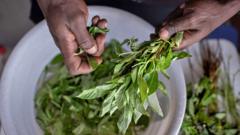**Once deemed poor man's food, these forgotten "weeds" are reclaiming their place on plates across Kenya, showing both nutritional superiority and cultural significance.**
**Reclaiming the Harvest: Indigenous Greens Find Favor in Kenya**

**Reclaiming the Harvest: Indigenous Greens Find Favor in Kenya**
**A transformation is underway in Kenyan culinary culture as indigenous leafy vegetables rise in popularity, challenging conventional greens.**
In Kenya, a shift in dietary preferences is transforming once-neglected indigenous leafy vegetables into culinary staples. Known locally as "kienyeji," these greens, previously dismissed as wild weeds or second-class food, are experiencing a surge in demand as their nutritional benefits come to light.
At Skinners Restaurant in Gachie, Nairobi, manager Kimani Ng'ang'a notes the increased requests for kienyeji, despite its higher price and more challenging sourcing. Traditional greens marketed extensively since colonial times, such as cabbage and spring greens—also known as "sukumawiki," meaning "stretch the week"—are being overshadowed by nutrient-rich alternatives like "managu" (African nightshade) and "mrenda" (jute mallow).
More Kenyans are embracing the health advantages of these indigenous vegetables, as highlighted by horticulture professor Mary Abukutsa-Onyango. Over the past decade, production has doubled, culminating in 300,000 tons harvested last year. Research confirms that these local varieties provide more minerals, vitamins A and C, and antioxidants compared to their colonial counterparts, making them an essential addition to diets.
The changing perception of indigenous crops has been a triumph against a historical backdrop where they were often referred to dismissively. Prof Abukutsa-Onyango’s advocacy for these vegetables played a key role in teaching their importance and resilience against pests, positioning them as a formidable choice for organic farming.
Kenya's efforts to document and preserve its food heritage, led by organizations and driven by community initiatives, received recognition from UNESCO in 2021. The project successfully cataloged over 850 traditional foods, including unique indigenous plants that reflect Kenya's diverse agricultural history.
However, the government’s stringent seed regulations hinder farmers from freely exchanging or selling indigenous seeds. This legislation, aimed at safeguarding against poor-quality seeds, threatens efforts to rejuvenate forgotten varieties. Farmers like Francis Ngiri, who have excelled in organic farming of indigenous crops, often find themselves at odds with these regulations.
With demand for indigenous greens growing, vendors like Priscilla Njeri in bustling markets are noticing a clear preference among consumers for these flavorful alternatives. Ongoing media campaigns highlighting their health benefits have further solidified their status in the marketplace.
While legislative challenges remain, the turning tide in consumer preferences towards indigenous vegetables marks a reawakening of Kenya's agricultural heritage, paving the way for a new, more diverse culinary landscape.
At Skinners Restaurant in Gachie, Nairobi, manager Kimani Ng'ang'a notes the increased requests for kienyeji, despite its higher price and more challenging sourcing. Traditional greens marketed extensively since colonial times, such as cabbage and spring greens—also known as "sukumawiki," meaning "stretch the week"—are being overshadowed by nutrient-rich alternatives like "managu" (African nightshade) and "mrenda" (jute mallow).
More Kenyans are embracing the health advantages of these indigenous vegetables, as highlighted by horticulture professor Mary Abukutsa-Onyango. Over the past decade, production has doubled, culminating in 300,000 tons harvested last year. Research confirms that these local varieties provide more minerals, vitamins A and C, and antioxidants compared to their colonial counterparts, making them an essential addition to diets.
The changing perception of indigenous crops has been a triumph against a historical backdrop where they were often referred to dismissively. Prof Abukutsa-Onyango’s advocacy for these vegetables played a key role in teaching their importance and resilience against pests, positioning them as a formidable choice for organic farming.
Kenya's efforts to document and preserve its food heritage, led by organizations and driven by community initiatives, received recognition from UNESCO in 2021. The project successfully cataloged over 850 traditional foods, including unique indigenous plants that reflect Kenya's diverse agricultural history.
However, the government’s stringent seed regulations hinder farmers from freely exchanging or selling indigenous seeds. This legislation, aimed at safeguarding against poor-quality seeds, threatens efforts to rejuvenate forgotten varieties. Farmers like Francis Ngiri, who have excelled in organic farming of indigenous crops, often find themselves at odds with these regulations.
With demand for indigenous greens growing, vendors like Priscilla Njeri in bustling markets are noticing a clear preference among consumers for these flavorful alternatives. Ongoing media campaigns highlighting their health benefits have further solidified their status in the marketplace.
While legislative challenges remain, the turning tide in consumer preferences towards indigenous vegetables marks a reawakening of Kenya's agricultural heritage, paving the way for a new, more diverse culinary landscape.




















